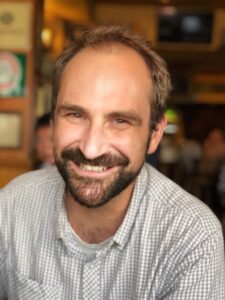 This week we met Jérôme Noailly, one of the key figures in the international in silico medicine scenario. Noailly is a Professor of Biomechanics, Biomaterials & Musculoskeletal Modelling, and a faculty researcher at the University Pompeu Fabra, in Barcelona, Spain, where he is currently developing with his team multi-scale models for tissue and organ regulation. He is also coordinating a EU-funded project, Disc4All, for translational research in intervertebral disc degeneration, that combines many sources of data and many Modeling & Simulation technologies.
This week we met Jérôme Noailly, one of the key figures in the international in silico medicine scenario. Noailly is a Professor of Biomechanics, Biomaterials & Musculoskeletal Modelling, and a faculty researcher at the University Pompeu Fabra, in Barcelona, Spain, where he is currently developing with his team multi-scale models for tissue and organ regulation. He is also coordinating a EU-funded project, Disc4All, for translational research in intervertebral disc degeneration, that combines many sources of data and many Modeling & Simulation technologies.
“In my team, we exploit Modeling & Simulation technologies to understand the role of mechanical and biochemical stimulations into proper maintenance of load-bearing tissues and organs. These efforts aim to provide us with reference mechanisms, that we can duly interpret to further explain degenerative processes upon multifactorial biological and physical perturbations of the systems that we study. Right now, these systems include body joints, bones, lungs and arteries. In terms of methodology, we couple classical approaches and computational engineering, such as finite element modeling with methods in computational biology, that include agent and network modeling”.
This combination of heterogeneous modeling technologies allows Dr. Noailly to virtually travel from organs to cells and molecules, in order to explore causative relationships involved in disorders such as intervertebral disc degeneration, osteoarthritis, osteoporosis, lung emphysema and atherosclerosis.
“We develop the models so that they can incorporate biological clinical evidence that are typically provided by laboratory experiments and clinical diagnostic tools. Hopefully this research can positively contribute to the target of biomarkers, risk factors, prevention and therapeutic strategies in highly multifactorial disorders that have long-term silent evolution. Many disorders – for example, rheumatological or vascular – are diagnosed after decades of silent evolution under the influence of many heterogeneous factors; once affected systems are decompensated there is not a unique cause anymore of this evolution. And it’s very challenging to identify any therapy that is not merely palliative.
As a consequence, affected people have dramatically decreased quality of life, with highly disabling chronic pain, for example in osteoarthritis, intervertebral disc degeneration, and risk of death in respiratory and vascular disorders. I believe that models and simulations are unique tools to identify personalized risk factors, therapeutical targets in an educated way, by taking into account molecule to organ regulation over different timescales. Especially, the potential ability to virtually simulate the dynamic propagation of specific perturbations over different timescales is a huge asset for prevention, early diagnosis in addition to therapy”.
The Modeling & Simulation approaches that Dr. Noailly is using for his research enter unraveled complexity and stand for mostly interpretation means. Validating these models is the real challenge because they simulate what cannot be measured with our current medical technologies.
“Parts of the models can be validated through experimental counterparts, but we shouldn’t forget that these counterparts are models themselves, disconnected from the real human body physiology. So, there is a clear problem of standardization of use and definition of safety, if we want to translate these complex models as tools in the healthcare industry. Molecular diagnostic technologies are evolving, and one day we might expect to achieve enough points of evidence to duly validate complex interpretable models for the exploitation of the healthcare industry.
However, having said that, models do not need to be complex to have a value, clinically speaking. High-level or phenomenological models and simulations can be much easier to validate against real world data. The most phenomenological models I can think of would be those that are mostly data-driven and that integrate algorithms for data analytics based on machine learning, for example.
These models can tremendously help in establishing relationships among heterogeneous data and improve patient stratification for more personalized diagnostic and treatments for many disorders. I think that this more accessible technology has a great potential to make its way into the healthcare industry. Actually, this is something that has started, and corresponding regulations for good practice safety liability are already being discussed by policymakers in collaborations with public regulation agencies and industry stakeholders”.
We can expect that, once these models will lead to repeatable success stories, for example in medical diagnostic, the transfer of technology of more complex forms of interpretable models and simulations will progress tremendously.”
